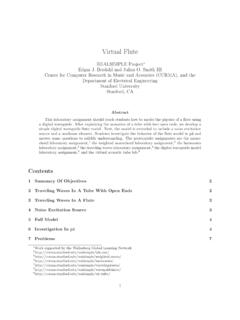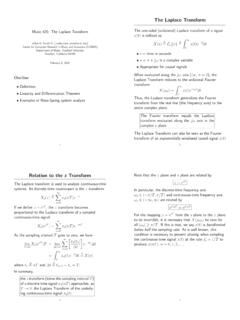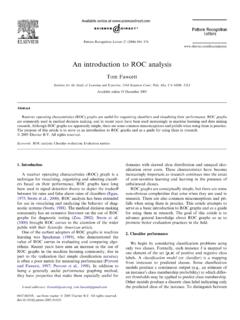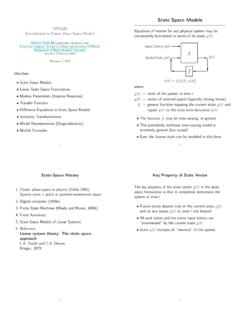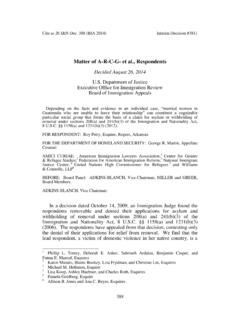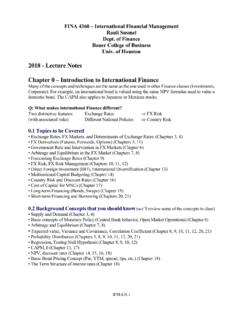Transcription of Matrix Calculus - Stanford University
1 Appendix DMatrix CalculusFrom too much study, and from extreme passion, cometh madnesse. Isaac Newton[205, 5] Gradient, Directional derivative, Taylor GradientsGradientof a differentiable real functionf(x) :RK Rwith respect to its vectorargument is defined uniquely in terms of partial derivatives f(x), f(x) x1 f(x) f(x) xK RK(2053)while the second-order gradient of the twice differentiable real function with respect toitsvector argument is traditionally called theHessian; 2f(x), 2f(x) x21 2f(x) x1 x2 2f(x) x1 xK 2f(x) x2 x1 2f(x) x22 2f(x) x2 2f(x) xK x1 2f(x) xK x2 2f(x) x2K SK(2054)interpreted 2f(x) x1 x2= f(x) x1 x2= f(x) x2 x1= 2f(x) x2 x1(2055)Dattorro,Convex Optimization Euclidean Distance Geometry,M oo, 2005, D. Matrix CALCULUSThe gradient of vector-valued functionv(x) :R RNon real domain is a row vector v(x),h v1(x) x v2(x) x vN(x) xi RN(2056)while the second-order gradient is 2v(x),h 2v1(x) x2 2v2(x) x2 2vN(x) x2i RN(2057)Gradient of vector-valued functionh(x) :RK RNon vector domain is h(x), h1(x) x1 h2(x) x1 hN(x) x1 h1(x) x2 h2(x) x2 hN(x) h1(x) xK h2(x) xK hN(x) xK = [ h1(x) h2(x) hN(x) ] RK N(2058)while the second-order gradient has a three-dimensional written representation dubbedcubix; 2h(x), h1(x) x1 h2(x) x1 hN(x) x1 h1(x) x2 h2(x) x2 hN(x) h1(x) xK h2(x) xK hN(x) xK = 2h1(x) 2h2(x) 2hN(x) RK N K(2059)where the gradient of each real entry is with respect to vectorxas in (2053).
2 The gradient of real functiong(X) :RK L Ron Matrix domain is g(X), g(X) X11 g(X) X12 g(X) X1L g(X) X21 g(X) X22 g(X) g(X) XK1 g(X) XK2 g(X) XKL RK L= X(:,1)g(X) X(:,2)g(X).. X(:,L)g(X) RK 1 L(2060)where gradient X(:, i)is with respect to theithcolumn ofX. The strange appearance of(2060) inRK 1 Lis meant to suggest a third dimension perpendicular to the page( wordmatrixcomes from the Latin forwomb; related to the prefixmatri-derived GRADIENT, DIRECTIONAL DERIVATIVE, TAYLOR SERIES601a diagonal Matrix ). The second-order gradient has representation 2g(X), g(X) X11 g(X) X12 g(X) X1L g(X) X21 g(X) X22 g(X) g(X) XK1 g(X) XK2 g(X) XKL RK L K L= X(:,1)g(X) X(:,2)g(X).. X(:,L)g(X) RK 1 L K L(2061)where the gradient is with respect to of vector-valued functiong(X) :RK L RNon Matrix domain is a cubix g(X), X(:,1)g1(X) X(:,1)g2(X) X(:,1)gN(X) X(:,2)g1(X) X(:,2)g2(X) X(:,2)gN(X).
3 X(:,L)g1(X) X(:,L)g2(X) X(:,L)gN(X) = [ g1(X) g2(X) gN(X) ] RK N L(2062)while the second-order gradient has a five-dimensional representation; 2g(X), X(:,1)g1(X) X(:,1)g2(X) X(:,1)gN(X) X(:,2)g1(X) X(:,2)g2(X) X(:,2)gN(X).. X(:,L)g1(X) X(:,L)g2(X) X(:,L)gN(X) = 2g1(X) 2g2(X) 2gN(X) RK N L K L(2063)The gradient of Matrix -valued functiong(X) :RK L RM Non Matrix domain hasa four-dimensional representation calledquartix(fourth-order tensor) g(X), g11(X) g12(X) g1N(X) g21(X) g22(X) g2N(X).. gM1(X) gM2(X) gMN(X) RM N K L(2064)while the second-order gradient has a six-dimensional representation 2g(X), 2g11(X) 2g12(X) 2g1N(X) 2g21(X) 2g22(X) 2g2N(X).. 2gM1(X) 2gM2(X) 2gMN(X) RM N K L K L(2065)and so D. Matrix Product rules for Matrix -functionsGiven dimensionally compatible Matrix -valued functions of Matrix variablef(X) andg(X) X f(X)Tg(X) = X(f)g+ X(g)f(2066)while [65, ] [420] Xtr f(X)Tg(X) = X tr f(X)Tg(Z) + tr g(X)f(Z)T Z X(2067)These expressions implicitly apply as well to scalar-, vector-, or Matrix -valuedfunctionsof scalar, vector, or Matrix (X) :R2 2 R2=XTaandg(X) :R2 2 R2=Xb.
4 We wish to find X f(X)Tg(X) = XaTX2b(2068)using the product rule. Formula (2066) calls for XaTX2b= X(XTa)Xb+ X(Xb)XTa(2069)Consider the first of the two terms: X(f)g= X(XTa)Xb= (XTa)1 (XTa)2 Xb(2070)The gradient ofXTaforms a cubix inR2 2 2; ,third-order tensor. (XTa)1 X11 JJJJJJ (XTa)2 X11 JJJJJJ (XTa)1 X12 (XTa)2 X12 (XTa)1 X21 JJJJJJ (XTa)2 X21 JJJJJJ (XTa)1 X22 (XTa)2 X22 X(XTa)Xb= (Xb)1(Xb)2 R2 1 2(2071)Because gradient of the product (2068) requires total change with respect to change ineach entry of matrixX, theXbvector must make an inner product with each vector inthat second dimension of the cubix indicated by dotted line segments; X(XTa)Xb= a100a1a200a2 b1X11+b2X12b1X21+b2X22 R2 1 2= a1(b1X11+b2X12)a1(b1X21+b2X22)a2(b1X11+b 2X12)a2(b1X21+b2X22) R2 2=abTXT(2072)where the cubix appears as a complete 2 2 2 Matrix . In like manner for the secondterm X(g) GRADIENT, DIRECTIONAL DERIVATIVE, TAYLOR SERIES603 X(Xb)XTa= b10b200b10b2 X11a1+X21a2X12a1+X22a2 R2 1 2=XTabT R2 2(2073)The solution XaTX2b=abTXT+XTabT(2074)can be found from verified using (2067).
5 Kronecker productA partial remedy for venturing intohyperdimensionalmatrix representations, such asthe cubix or quartix, is to first vectorize matrices as in (39). This device gives riseto the Kronecker product of matrices ; ,tensor product(kron()in Matlab).Although its definition sees reversal in the literature, [434, ] Kronecker product is notcommutative (B A6=A B). We adopt the definition: forA Rm nandB Rp qB A, B11A B12A B1qAB21A B22A Bp2A BpqA Rpm qn(2075)for whichA 1 = 1 A=A(real unity acts like Identity).One advantage to vectorization is existence of the traditional two-dimensionalmatrixrepresentation (second-order tensor) for the second-order gradient of a real function withrespect to a vectorized Matrix . From ( ) for squareA , B Rn n, forexample [220, ] [15, 3] 2vecXtr(AXBXT) = 2vecXvec(X)T(BT A) vecX=B AT+BT A Rn2 n2(2076)To disadvantage is a large new but known set of algebraic rules ( ) and the factthat its mere use does not generally guarantee two-dimensional Matrix representation application of the Kronecker product is to reverse order of appearance ina Matrix product: Suppose we wish to weight the columns of a matrixS RM N, forexample, by respective entrieswifrom the main diagonal inW, SN(2077)A conventional means for accomplishing column weighting is to multiplySby diagonalmatrixWon the right side:S W=S = S(:,1)w1 S(:, N)wN RM N(2078)To reverse product order such that diagonal matrixWinstead appears to the left ofS:forI SM(Law)S W=( (W)T I) S(:,1)000S(:,2).
6 000S(:, N) RM N(2079)604 APPENDIX D. Matrix CALCULUSTo instead weight the rows ofSvia diagonal matrixW SM, forI SNW S= S(1,:)000S(2,:)..000S(M ,:) ( (W) I) RM N(2080) Hadamard productFor any matrices of like size,S , Y RM N, Hadamard s product denotes simplemultiplication of corresponding entries (.*in Matlab). It is possible to convert Hadamardproduct into a standard product of matrices:S Y= (Y(:,1)) (Y(:, N)) S(:,1)000S(:,2)..000S(:, N) RM N(2081)In the special case thatS=sandY=yare vectors inRMs y= (s)y(2082)sT y=ysTs yT=syT(2083) Chain rules for composite Matrix -functionsGiven dimensionally compatible Matrix -valued functions of Matrix variablef(X) andg(X) [462, ] Xg f(X)T = XfT fg(2084) 2Xg f(X)T = X XfT fg = 2Xf fg+ XfT 2fg Xf(2085) Two arguments Xg f(X)T, h(X)T = XfT fg+ XhT hg(2086) rule for two arguments.[51, ]g f(x)T, h(x)T =(f(x) +h(x))TA(f(x) +h(x))(2087)f(x) = x1 x2 ,h(x) = x1x2 (2088) xg f(x)T, h(x)T = 1 00 (A+AT)(f+h) + 00 1 (A+AT)(f+h) (2089) xg f(x)T, h(x)T = 1 + 00 1 + (A+AT) x1 x2 + x1x2 (2090)lim 0 xg f(x)T, h(x)T = (A+AT)x(2091)from foregoing formulae remain correct when gradient produces GRADIENT, DIRECTIONAL DERIVATIVE, TAYLOR First directional derivativeAssume that a differentiable functiong(X) :RK L RM Nhas continuous first- andsecond-order gradients gand 2gover domgwhich is an open set.
7 We seeksimple expressions for the first and second directional derivatives in directionY RK L:respectively, Ydg RM Nand Ydg2 RM that the limit exists, we may state the partial derivative of themnthentryofgwith respect toklthentry ofX; gmn(X) Xkl= lim t 0gmn(X+ t ekeTl) gmn(X) t R(2092)whereekis thekthstandard basis vector inRKwhileelis thelthstandard basis vector inRL. Total number of partial derivatives equalsKLM Nwhile the gradient is defined intheir terms;mnthentry of the gradient is gmn(X) = gmn(X) X11 gmn(X) X12 gmn(X) X1L gmn(X) X21 gmn(X) X22 gmn(X) gmn(X) XK1 gmn(X) XK2 gmn(X) XKL RK L(2093)while the gradient is a quartix g(X) = g11(X) g12(X) g1N(X) g21(X) g22(X) g2N(X).. gM1(X) gM2(X) gMN(X) RM N K L(2094)By simply rotating our perspective of a four-dimensional representation of gradient Matrix ,we find one of three useful transpositions of this quartix (connotedT1): g(X)T1= g(X) X11 g(X) X12 g(X) X1L g(X) X21 g(X) X22 g(X) g(X) XK1 g(X) XK2 g(X) XKL RK L M N(2095)When a limit for t Rexists, it is easy to show by substitution of variables in (2092) gmn(X) XklYkl= lim t 0gmn(X+ t YklekeTl) gmn(X) t R(2096)which may be interpreted as the change ingmnatXwhen the change inXklis equaltoYkltheklthentry of anyY RK L.
8 Because the total change ingmn(X) due toYisthe sum of change with respect to each and everyXkl, themnthentry of the directionalderivative is the corresponding total differential [462, ]606 APPENDIX D. Matrix Calculus dgmn(X)|dX Y=Xk, l gmn(X) XklYkl= tr gmn(X)TY (2097)=Xk, llim t 0gmn(X+ t YklekeTl) gmn(X) t(2098)= lim t 0gmn(X+ t Y) gmn(X) t(2099)=ddt t=0gmn(X+t Y)(2100)wheret R. Assuming finiteY, equation (2099) is called theG ateaux differential[50, ] [265, ] [474, ] whose existence is implied by existence of theFr echet differential(the sum in (2097)). [337, ] Each may be understood as the changeingmnatXwhen the change inXis equal in magnitude and direction directional derivative, Ydg(X), dg11(X)dg12(X) dg1N(X)dg21(X)dg22(X) dg2N(X)..dgM1(X)dgM2(X) dgMN(X) dX Y RM N= tr g11(X)TY tr g12(X)TY tr g1N(X)TY tr g21(X)TY tr g22(X)TY tr g2N(X)TY ..tr gM1(X)TY tr gM2(X)TY tr gMN(X)TY = Pk, l g11(X) XklYklPk, l g12(X) XklYkl Pk, l g1N(X) XklYklPk, l g21(X) XklYklPk, l g22(X) XklYkl Pk, l g2N(X) , l gM1(X) XklYklPk, l gM2(X) XklYkl Pk, l gMN(X) XklYkl (2101)from which it follows Ydg(X) =Xk, l g(X) XklYkl(2102)Yet for allX domg, anyY RK L, and some open interval oft Rg(X+t Y) =g(X) +t Ydg(X) + O(t2)(2103)which is the first-order multidimensional Taylor series expansion aboutX.
9 [462, ][203, ] Differentiation with respect totand subsequentt-zeroing isolates the secondterm of expansion. Thus differentiating and zeroingg(X+t Y) intis an operationequivalent to individually differentiating and zeroing every entrygmn(X+t Y) as in(2100). So the directional derivative ofg(X) :RK L RM Nin any directionY RK Levaluated atX domgbecomes Ydg(X) =ddt t=0g(X+t Y) RM N(2104) a Matrix , we may regard it as a vector GRADIENT, DIRECTIONAL DERIVATIVE, TAYLOR SERIES607( , f( )) H Tf(x)f( +t y) , xf( )12 xf( )df( ) Figure 216: Strictly convex quadratic bowl inR2 R;f(x) =xTx:R2 Rversusxon some open disc inR2. Plane slice His perpendicular to function domain. Sliceintersection with domain connotes bidirectional vectory. Slope of tangent lineTatpoint( , f( ))is value of directional derivative xf( )Ty(2129) at in slice gradient xf(x) R2is direction ofsteepest descent. [74, ] [462, ][203] [519] When vector R3entry 3is half directional derivative in gradient directionat and when 1 2 = xf( ) , then points directly toward bowl bottom.
10 [371, , ] [43, ] which is simplest. In case of a real functiong(X) :RK L R Ydg(X) = tr g(X)TY (2126)In caseg(X) :RK R Ydg(X) = g(X)TY(2129)Unlike gradient, directional derivative does not expand dimension; directionalderivative (2104) retains the dimensions ofg. The derivative with respect totmakesthe directional derivative resemble ordinary Calculus ( ); , wheng(X) is linear, Ydg(X) =g(Y). [337, ] Interpretation of directional derivativeIn the case of any differentiable real functiong(X) :RK L R, the directional derivativeofg(X) atXin any directionYyields the slope ofgalong the line{X+t Y|t R}through its domain evaluated att= 0. For higher-dimensional functions, by (2101), thisslope interpretation can be applied to each entry of the directional , for example, shows a plane slice of a real convex bowl-shaped functionf(x) along a line{ +t y|t R}through its domain. The slice reveals a one-dimensionalreal function oft;f( +t y).
